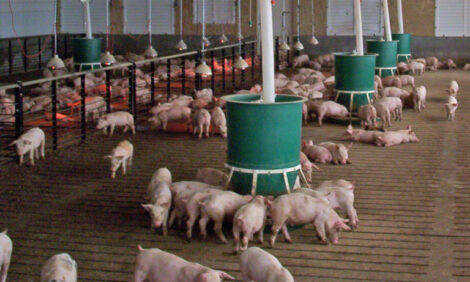



Impact of genetic selection on management
By J.A.B. Robinson and M.M. Buhr, University of Guelph - Boars in an artificial insemination centre have been selected for their superior genetic potential, with ‘superior’ being defined as having traits the customer wants transmitted to his herd.Abstract
The ability to meet the customers’ needs depends on the heritability of the trait, the geneticist’s success in devising a selection scheme for the trait in balance with other economically important traits, and the boar’s ability to produce sperm that can fertilise oocytes.
Genetic evaluation research over the past 20
years has greatly increased the number of traits for which a boar can be selected: currently in the
Canadian national program, these include age at 100 kg, backfat at 100 kg, feed efficiency, lean yield
and litter size. In the near future, traits that are very likely to be added to this selection list include
piglet survival, marbling, loin eye area and structure traits. In Canada, sires are ranked on two
estimated breeding value (EBV) indices; one, focused on development of terminal sire lines, is based
on the growth and yield traits and another, primarily focused on maternal line development, deemphasises
these traits and incorporates litter size.
Boars that are in Canadian AI centres because of their excellent growth traits are typically in the
top 5–10% of the national population for terminal sire line index, but they may be only average or
substandard for litter size. Conversely, boars selected to be in the top 5–10% for conveying such
reproductive traits as litter size may only be in the top 33% for growth traits. The more offspring from
a superior boar in either of these indices, the faster the population average for the trait improves. The
original sire gets knocked out of the elite group, is culled and replaced by a higher ranked young boar
from the now improved general population.
Although genetic superiority should govern an AI centre’s selection and culling of boars,
decision-making in real life is seldom that simple. Selection criteria may be contradictory as above,
or a boar with truly superior traits may be excluded because a newly-developed molecular genetics
test determines he carries an undesirable gene such as PSS, RN or others being developed. Selection
for terminal sire or maternal line traits can ignore important practical factors that affect an AI
centre—boars with superior genetics may not produce good semen because skeletal or penile
problems prevent ejaculation, or because sperm production is poor due to a genetic flaw, disease, or
some other cause. Interestingly, selection pressure for one trait may inadvertently select for a trait that
is linked but whose linkage is unrecognised, and such unintentionally selected genes could benefit,
harm, or have no effect on production traits.
An AI centre serving a variety of customers must select boars in anticipation of their customers’
needs (including new, foreign and niche markets). A centre should also review its genetic evaluation
results and progeny records, both to critique its own selection success and to try to detect unexpected
linkages. Finally, an AI centre needs to predict its own future, selecting not just for production traits
for the swine producer, but also for factors that enhance the centre’s efficiency including boar
conformation and temperament, and sperm quantity, quality and hardiness. Can we select for
efficiency? Our colleagues in dairy cattle AI evaluate bull performance—should the swine industry
consider evaluation of male fertility traits?
Further Information
To continue reading this article click here (PDF)
Source: Animal & Poultry Science University of Guelph and published by Elsevier Inc - Reproduced September 2005








